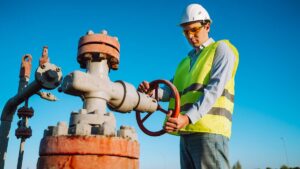Global energy transition makes its mark on oil and gas acquisition, exploration and development

Pic: Vertigo3d / E+ via Getty Images
The face of the oil and gas exploration sector is changing as the world moves increasingly towards the use of renewable energy such as solar, wind and water along with more efficient use of energy.
While there is still a role for oil and gas to play, global consultancy Wood Mackenzie expects major changes to the way that the industry allocates across mergers and acquisitions, exploration and development.
Firstly, WoodMac expects companies to focus future M&A activity on adding additional resources to their portfolios to increase their resilience in the face of long-term demand uncertainty.
“From 2005 to 2014, 37 per cent of the new resource added to upstream portfolios came from M&A,” research director Angus Rodger said.
“In the last three years (2015 to 2018), this has risen to 46 per cent. Yet at the same time global M&A activity declined since 2014.”
This is due largely to investor pressure in the US, where the market is pursuing capital discipline and greater profitability rather than acquisitive growth.
Conversely, M&A activity in Asia Pacific has remained relatively busy though it remains to be seen if this can be maintained as majors continue to trim their non-core assets.
“Three quarters of the majors’ Asia Pacific portfolios by value sit in Australia. This reflects both the importance of cash-generative long-life LNG assets, and the key role of gas in the energy transition,” Harwood said.
“Other regional projects that cannot compete for capital in the face of low-cost, high-margin opportunities elsewhere will become increasingly non-core.”
Rodger added that while the exploration industry had recovered since the downturn by focusing on a smaller number of world-class, and often oil-prone, regions, there was change in the air as gas became a greater focus.
“Of all volumes discovered over the last decade, over 50 per cent was gas, and it is steadily increasing,” he said.
“But while the ‘bridge fuel’ is seen by many players as a key plank of their energy transition strategies, gas is simply worth less than oil on a unit basis. Its per barrel of oil equivalent (boe) development value is often a third less than oil.
“That said, as with M&A, we have reasons to be more optimistic around the Asia Pacific outlook. Proximity to existing infrastructure and strong gas demand offers incentives for gas exploration.”
WoodMac expects to see more exploration in offshore North Sumatra, Indonesia, onshore Northern Territory, Australia and Sabah, Malaysia, as companies sought to offset declining utilisation across a number of key pipelines and liquefaction plants in Asia.
Meanwhile, Harwood said the majors were turning more to technology to unlock more value from existing fields.
The use of seismic advances, data analytics, machine learning and more have allowed them to unlock 19 billion barrels of conventional and tight oil resources from their portfolios since the oil price downturn, a third of all reserves added in that time.
“We have seen this approach bear fruit in Asia Pacific, with Woodside recently upgrading resources at its Scarborough project by 52 per cent through the application of new seismic techniques and processing,” Hardwood said.
“Given the maturity of much of the existing resource base in Asia Pacific, new approaches to improving recovery could prove an effective means of boosting the supply outlook.
“Just a 5 per cent increase in recovery from producing assets in Asia could add another 5 billion boe of resource – equivalent to the volume of exploration-led resources added in Asia Pacific over the last three years.”
Rodger added that the carbon footprint of assets was also a growing concern for public-listed companies.
This could result in some of the largest stranded assets across Asia Pacific failing the test for development due to high levels of carbon dioxide and other contaminants.
UNLOCK INSIGHTS
Discover the untold stories of emerging ASX stocks.
Daily news and expert analysis, it's free to subscribe.
By proceeding, you confirm you understand that we handle personal information in accordance with our Privacy Policy.








